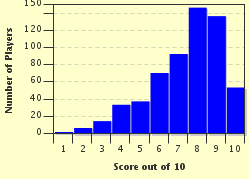Quiz Answer Key and Fun Facts
1. A suitor may cut in by tapping a dancing partner on the shoulder and taking his place. A driver may cut in when merging with freeway traffic from an on-ramp. One who interrupts a conversation may be said to be cutting in. What does it mean to "cut in" in the kitchen?
2. Alfred, Lord Tennyson wrote "In the Spring a young man's fancy lightly turns to thoughts of love." Posting bail is one way to get sprung from jail. One who buys another's supper springs for the check. What does the term spring mean in baking?
3. Hominy Falls is a community in West Virginia. Frederick Douglass Opie wrote a book on the origins of soul food called "Hog and Hominy." From what is hominy made?
4. Your cookbook, printed in Great Britain, calls for aubergine. In the United States, Australia, New Zealand, and Canada, what is the correct word for aubergine?
5. In the Song of Solomon in the Old Testament, the writer says his beloved's garments are scented with cinnamon. Kids make cinnamon toast by sprinkling a combination of ground cinnamon and sugar on hot buttered toast. Fine ground cinnamon comes in a spice jar; from what is it ground?
6. Cocktail recipes sometimes call for a dash of bitters. Older cookbooks sometimes call for "just a dash" of some ingredient. How much is a dash?
7. Cookbooks encourage cooks to prepare mise en place. Professional cooking schools emphasize mise en place in their training. Professional kitchens absolutely require all cooks to have mise en place. But what is it?
8. A German Jewish chef is visiting your restaurant and asks you to fetch her some schmaltz. What does she want?
9. In Act II, Scene 1, of Shakespeare's "The Taming of the Shrew," Petruchio says of Katherine: "Kate like the hazel-twig is straight and slender and as brown in hue as hazel nuts, and sweeter than the kernels." What is the other common name for hazelnuts?
10. Leadbelly sings a song about an old "Grey Goose" his daddy shot and, after they plucked it, his wife put it on to parboil for six months to get it tender. What exactly is the meaning of parboil?
Source: Author
FatherSteve
This quiz was reviewed by FunTrivia editor
WesleyCrusher before going online.
Any errors found in FunTrivia content are routinely corrected through our feedback system.


